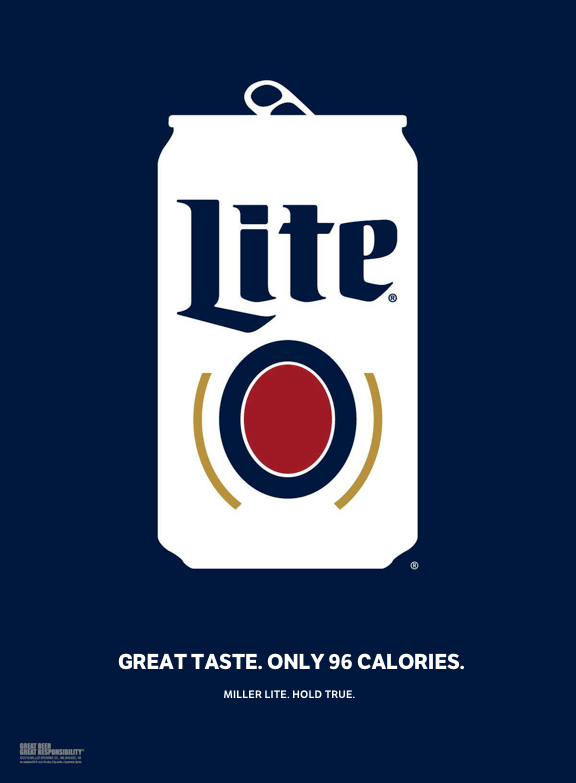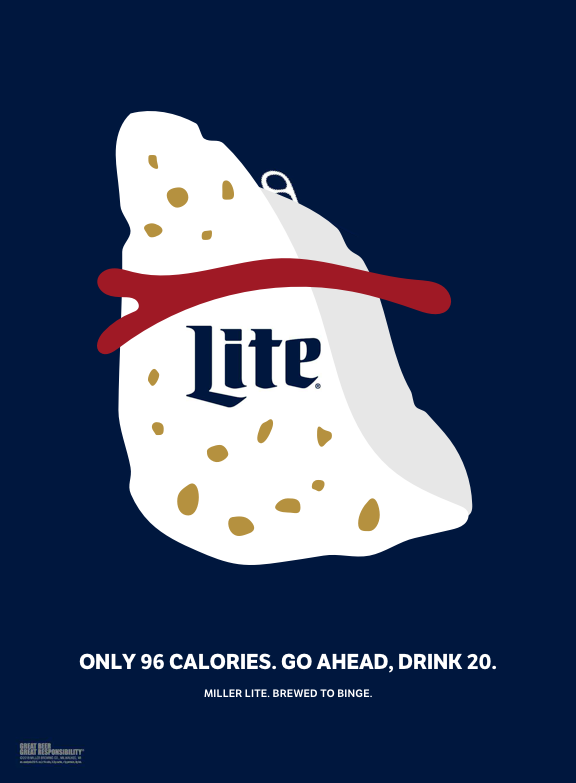
I found this advertisement in the June 2018 edition of GQ. At first I was drawn to its simplicity; I’ve seen variations of Miller Lite’s new marketing campaign — a simple silhouette of a beer can on a blue background — on billboards, television spots and in magazines, and was admittedly fond of the basic aesthetic. Compared to many alcohol advertisements, it seemed very straight to the point: drink Miller, not because it tastes the best, but because it’s smooth and easy. The lightness of the design — a small soft white can with minimal branding — seems to convey the message that Miller Lite is simple and pure. The added tagline and boast of “only 96 calories” emphasizes the point: drink Miller Lite and you won’t get fat. It’s the healthy choice.
However, it’s still beer. Light beer in particular holds a steadfast position in North American culture. It’s the beer of choice at sports games, barbecues and college parties, and whether it’s Coors, Miller or Budweiser, people drink it because they think it’s healthier. But is that really the reason?
I think it’s important to recognize the relationship between light beer and binge drinking. While it may be marketed as a healthy (and cheap) alternative to stronger stouts and lagers, it’s a well-known fact that light beer is easier to drink in large quantities. It’s not uncommon for somebody to drink a strong beer and feel full and bloated. But a light beer? Sure, I’ll have another.
Alcoholism is a huge problem in both the United States and Canada. Drinking is glorified through many aspects of our culture, and light beer is a distinctly North American invention. The problem with this advertisement, in my opinion, is that it portrays Miller Lite as a healthy choice, when really it’s just another alcoholic beverage. A beer with fewer calories isn’t necessarily healthier — it’s just easy to drink. That, to me, is worrisome.

The goal of this jamming was to emphasize the negative effects of alcohol consumption. I stole the colours and design style from Miller’s original advertisement, but replaced the beer can with a diseased liver — presumably caused by alcoholism. Liver disease is just one of many consequences of alcoholism, but it often goes unseen and is rarely talked about. I thought it would be especially impactful to display a bad liver because it is in such contrast to the original image of a light, innocent can of beer.
The original advertisement attempts to hide the negative connotations that come along with alcohol consumption by simplifying the act in a single graphic. Symbolism is powerful, but it can also be used to hide certain images or thoughts associated with a product. My jamming reverses this, and attempts to make its message abundantly clear: light beer has fewer calories, but you’re probably going to drink a lot more of it. Heavy drinking is a very unhealthy habit and one that has become alarming prevalent in mainstream culture. Instead of glorifying the act or hiding its existence, why not make it abundantly clear?
I kept part of the original tagline — “only 96 calories” — and followed it up with a tongue-in-cheek phrase that helps drive home the point of this mashup. It’s light, so you can drink a lot of it! The phrase “brewed to binge” was chosen partly because of its alliteration, and also because it almost sounds like the kind of slick catchphrase that a marketing agency would create.